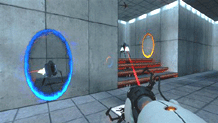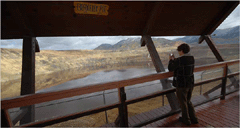

Pop!Tech is one of the most interesting conferences devoted to new ideas — it fried my brain the year I attended. And that guy Hasan Elahi, who I profiled? I heard about it because he did a presentation on his photoblogging work at last year’s conference. This year’s three-day conference begins tomorrow morning, and they’re streaming the entire conference live on this page, so you can attend Pop!Tech virtually, while never leaving the comfort of your joyless cubicle.
Personally, I plan to tune in to the session on “The Creative Instinct”, tomorrow from 5 pm to 6:30 pm. The four presenters include Caleb Chung — the incredibly smart robotics inventor who created the Furby, and who I wrote about for Wired last year — and Jessica Hagy, who has made an art form out of drawing faux-corporate flow-charts.

During my Great Blogging Drought of summer 2007, I actually published a dozen or so articles that, bien sur, I didn’t blog about because I wasn’t blogging. So I’m going to slowly post ‘em over the next month or so.
This piece was particularly fun to write: A short profile of Hasan Elahi, an artist guy who accidentally got put on the feds’ watchlists. He realized the best way to keep the FBI off his back was to go totally transparent — so he started photoblogging everything he does, all day long, to establish a constant alibi.
Wired published the piece back in May, so it’s on their site, and a permanently archived copy is below!
The Visible Man: An FBI Target Puts His Whole Life Online
by Clive ThompsonHasan Elahi whips out his Samsung Pocket PC phone and shows me how he’s keeping himself out of Guantanamo. He swivels the camera lens around and snaps a picture of the Manhattan Starbucks where we’re drinking coffee. Then he squints and pecks at the phone’s touchscreen. “OK! It’s uploading now,” says the cheery, 35-year-old artist and Rutgers professor, whose bleached-blond hair complements his fluorescent-green pants. “It’ll go public in a few seconds.” Sure enough, a moment later the shot appears on the front page of his Web site, TrackingTransience.net.
There are already tons of pictures there. Elahi will post about a hundred today — the rooms he sat in, the food he ate, the coffees he ordered. Poke around his site and you’ll find more than 20,000 images stretching back three years. Elahi has documented nearly every waking hour of his life during that time. He posts copies of every debit card transaction, so you can see what he bought, where, and when. A GPS device in his pocket reports his real-time physical location on a map.
Elahi’s site is the perfect alibi. Or an audacious art project. Or both. The Bangladeshi-born American says the US government mistakenly listed him on its terrorist watch list — and once you’re on, it’s hard to get off. To convince the Feds of his innocence, Elahi has made his life an open book. Whenever they want, officials can go to his site and see where he is and what he’s doing. Indeed, his server logs show hits from the Pentagon, the Secretary of Defense, and the Executive Office of the President, among others.

Behold the majestic Strix varia — otherwise known as the Barred Owl. Possessed of a three-and-a-half-foot wingspan and a particularly gnarly hoot, the Barred Owl historically was known to thrive only in old-growth forests. Why? Because it hunts by sitting on a branch and waiting for something to move, a technique that doesn’t work in a younger forest with smaller trees and dense, tall underbrush. It craves the cathedral-like openness of superold trees. And so back in the 60s and 70s, ornithologists feared that as old-growth forests across the US were cut down, the Barred Owl would eventually and tragically vanish.
But that hasn’t happened. The Barred Owl is thriving — because, interestingly, it has migrated to urban and suburban settings. Rob Bierregaard, an ornithologist at the University of North Carolina, had noticed that the suburbs of Charlotte were home to tons of Barred Owls. So he began a six-year-long study to ask the question: Why do Barred Owls thrive in the ‘burbs?
The answer, it turns out, is delightfully ironic: As far as the owls are concerned, the suburbs actually resemble old-growth forest. As Bierregaard puts it in this press release:
“When you look at suburban Charlotte, what do we have? We’ve got giant old willow oak trees with plenty of holes in them and we’ve got mowed lawns and azalea bushes, which is a very open understory, so they can see a long way. The habitat is an ‘uber’ old growth forest for owls because the understory is so open and there are plenty of birdfeeders to attract prey.”
Apparently, the only serious hazard the Charlotte owls face is the same one that threatens suburban humans: Automobiles. Collisions with cars are the leading cause of owl death. (Though it’s possible that cars are also helping to cull the owls, preventing the population from exploding and starving itself.)

Last week, Wired News published my latest video-game column — and this one is about Portal, an incredibly weird and cool teleportation game that, as I discover, winds up playing some nifty tricks with physics.
The column is online here, and a permanent copy is below!
In Portal, Violating Physics Proves Weirdly Satisfying
by Clive ThompsonFanboy warning: This column contains some mild gameplay spoilers.
Pretty much everyone who plays Portal, the new space-bending videogame, immediately tries a little physics experiment.
In Portal, you control a gun that can blast two connected oval portals on different surfaces — floors, ceilings and walls. If you step through the first portal, you emerge immediately from the other, teleported instantaneously through space, as if you walked through a magic mirror.
This quickly leads any curious player to try a little stunt: You put a portal on the floor in front of you, and then one on the ceiling directly above it. Step into the first hole, and you instantly fall out of the hole in the ceiling — whereupon you fall back into the hole on the ground. Woo hoo! You are now falling endlessly through the holes, over and over again, in a dreamlike, self-created infinite loop.
Let me tell you: It is awesomely fun. And it’s only the beginning of the seriously weird things you can do inside Portal, a game that neatly blows open the way you’ll think about the space inside games.

Video technology has transformed the way athletes train for sports, because they can review their performance — and that of their opponents — in nuanced, frame-by-frame detail. But most athletes can only do this after or before a game is over.
The exception is David Ortiz — who studies video in near real-time, while a game is still ongoing. Ortiz is a designated hitter for the Red Sox, and each time he bats, he heads back to the clubhouse, cracks open his laptop, and studies the pitches that were being thrown at him mere minutes earlier. Better yet, according to this piece in the New York Times, he’s apparently got a huge database of every pitch he’s ever faced:
With one click, Ortiz can also watch every at-bat that he has ever had against Sabathia in case he wants to search for a specific pitch. The batter-pitcher history compiled by the team is condensed to only include the pitches, not any tosses to first or visits from the pitching coach. It is all meat, no filler.
As the game progresses into the later innings and Ortiz speculates that he might oppose a left-handed reliever like Rafael Perez, he will study the at-bats that he has had off Perez. To Ortiz, knowledge equals power.
“That’s the real deal,” Ortiz said. “That’s the view of what you want to do differently from what you did before. If you see something good, you want to stick with it. If you do something wrong, you want to fix it.”
Personally, I think it’d be interesting to just blow things open completely and let pro sports athletes don wearable computers with craploads of telemetry: 360-degree radar, infrared vision, instant playback, voice messaging. Just imagine the sick plays they could pull off!

This clip went around the blogosphere a few months ago, but it’s new to me, and if you haven’t seen it — you really must. It’s video of some tunnel in Russia that becomes iced over, and when cars and trucks hit the icy patches, things go completely and nonlinearly berserk.
I really shouldn’t laugh while I watch this stuff — people are probably being hurt in some of these collisions — but man alive, it’s demented. I have played video games in which the whole goal is to engineer car collisions and never achieved wreckage like this.
I think part of what makes it so gripping is how the cars’ skidding comes completely outta nowhere. One minute, they’re trundling along in a perfectly straight line; then next minute, zing, they’re sliding along in a perfect, Tsuchiyan drift.
(Thanks to AllanDuke1 for this!)

Dig this: A couple of chemists have discovered new breeds of extremophiles — organisms that survive incredibly caustic environments — living at the bottom of an acidic copper-mine pit.
The Berkeley Pit is a copper mine that was abandoned in 1982; it’s 1,780 feet deep and a mile and a half wide. In the last twenty-five years, it has filled with water, and as the water has soaked up the residual arsenic, aluminum, cadmium and zinc, the pond has turned as acidic as vinegar. In 1995, a couple hundred geese landed on the water and instantly died. Nice.
Nonetheless, Don and Andrea Stierl — two chemists who live nearby — wondered if any lifeforms could endure such grim surroundings, so they pulled out some of the pond’s goo and cultured it in Petri dishes. Whaddya know: They’ve found 142 organisms in the muck, and have isolated 80 chemical compounds that exist nowhere else. Better yet, it looks as though some of those compounds might be useful in killing tumors!
As a terrific story in last week’s New York Times pointed out:
Microbes react to harsh conditions in the Berkeley Pit by switching on genes that otherwise lay dormant or by evolving through mutation and natural selection, Mr. Stierle said. Either way, they produce new chemical compounds, which the Stierles hope may benefit human health.
The couple have become intimately acquainted with the personalities of these new microorganisms. The pit’s strain of mycobacterium is a slimy, obstinate fungus that smells bad and is difficult to cultivate in a laboratory. But it has shown initial success in fighting some pathogens, Ms. Stierle said.
Then there is Penicillium rubrum, which is fuzzy and green like bread mold. “It’s sweet, it grows, and this little guy produces large amounts of interesting compounds,” she said. “It’s one of the loveliest microbes we’ve ever worked with.”
This story is a bouquet of all the things I love about science. It offers: a) A couple of total outsiders making discoveries by looking off the beaten path; b) proof once again that, quite apart from the sheer intellectual pleasures of exploring extreme environments, there’s often enormous practical benefits in doing so; c) more evidence that we probably ought to preserve environmentally untouched zones of the Earth, because they probably harbor weird, cool and useful lifeforms; d) an even cooler suggestion that we also ought to be carefully studying the total toxic wreck-dumps left behind by industrial pollution, because, man, who knows, eh?
And best of all, e): Yet more experimental proof that the principle of evolution works precisely as it’s been described for decades.
That picture above, by Lynn Donaldson, beautifully illustrated the Times piece. Go check it out in full-size.

Quick: Can you do long division? Probably, though you’d have to concentrate to remember how. Odds are you learned this years ago in grade school, but in a modern world filled with Excel and calculators, who needs to actually perform long division by pencil? Almost no-one. And if you stop practicing long division, maybe eventually you sort of forget how to do it. You’ve outsourced it to the machines around you.
This is subject of my latest column in the current issue of Wired magazine: The fate of human memory in a world where we’re increasingly reliant on machine memory. The piece is online for free at Wired’s site, and a copy is also permanently archived below:
Your outboard brain knows all
by Clive ThompsonWe’re running out of memory.
I don’t mean computer memory. That stuff’s half-price at Costco these days. No, I’m talking about human memory, stored by the gray matter inside our heads. According to recent research, we’re remembering fewer and fewer basic facts these days.
This summer, neuroscientist Ian Robertson polled 3,000 people and found that the younger ones were less able than their elders to recall standard personal info. When Robertson asked his subjects to tell them a relative’s birth date, 87 percent of respondents over age 50 could recite it, while less than 40 percent of those under 30 could do so. And when he asked them their own phone number, fully one-third of the youngsters drew a blank. They had to whip out their handsets to look it up.
That reflexive gesture — reaching into your pocket for the answer — tells the story in a nutshell. Mobile phones can store 500 numbers in their memory, so why would you bother trying to cram the same info into your own memory? Younger Americans today are the first generation to grow up with go-everywhere gadgets and services that exist specifically to remember things so that we don’t have to: BlackBerrys, phones, thumb drives, Gmail.
A Wired magazine reader checked out my latest column on the fate of human memory — in a world where are brains are increasingly reliant upon silicon smarts — and emailed me an excellent anecdote. Check it out:
Your article reminds me of a funny thing that happened when we were on vacation.
We rented a beach home with a few other families and the Moms declared that it would be an Internet-Free Week.
Well, it rained…and rained…and rained…and rained.
So on the forth straight day of rain, we all agreed that we needed to rent videos. But none of us remembered how to use a phone book properly.
“What do you think it would be under? Movie rental or Video Rental”
“how about you look up Blockbuster?”
“Is that in the yellow or white part”
You get so used to the online experience, it’s almost funny.
Heh. It reminds me of a moment back in December of 2002, when I was so busy trying using my Sidekick to locate a Supercuts haircut salon in my neighborhood that I failed to simply look up and notice that I was … sitting right in front of it.
I'm Clive Thompson, the author of Smarter Than You Think: How Technology is Changing Our Minds for the Better (Penguin Press). You can order the book now at Amazon, Barnes and Noble, Powells, Indiebound, or through your local bookstore! I'm also a contributing writer for the New York Times Magazine and a columnist for Wired magazine. Email is here or ping me via the antiquated form of AOL IM (pomeranian99).

ECHO
Erik Weissengruber
Vespaboy
Terri Senft
Tom Igoe
El Rey Del Art
Morgan Noel
Maura Johnston
Cori Eckert
Heather Gold
Andrew Hearst
Chris Allbritton
Bret Dawson
Michele Tepper
Sharyn November
Gail Jaitin
Barnaby Marshall
Frankly, I'd Rather Not
The Shifted Librarian
Ryan Bigge
Nick Denton
Howard Sherman's Nuggets
Serial Deviant
Ellen McDermott
Jeff Liu
Marc Kelsey
Chris Shieh
Iron Monkey
Diversions
Rob Toole
Donut Rock City
Ross Judson
Idle Words
J-Walk Blog
The Antic Muse
Tribblescape
Little Things
Jeff Heer
Abstract Dynamics
Snark Market
Plastic Bag
Sensory Impact
Incoming Signals
MemeFirst
MemoryCard
Majikthise
Ludonauts
Boing Boing
Slashdot
Atrios
Smart Mobs
Plastic
Ludology.org
The Feature
Gizmodo
game girl
Mindjack
Techdirt Wireless News
Corante Gaming blog
Corante Social Software blog
ECHO
SciTech Daily
Arts and Letters Daily
Textually.org
BlogPulse
Robots.net
Alan Reiter's Wireless Data Weblog
Brad DeLong
Viral Marketing Blog
Gameblogs
Slashdot Games